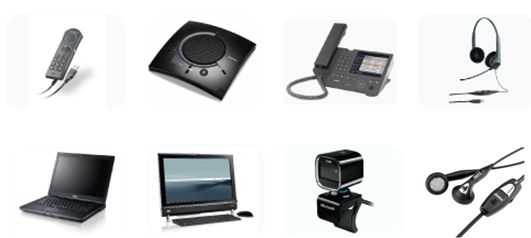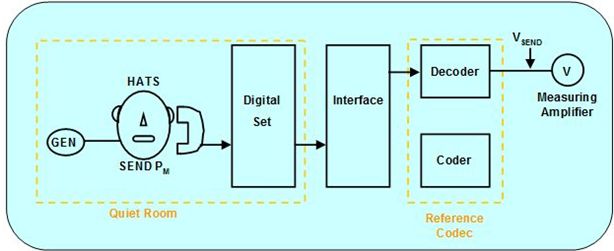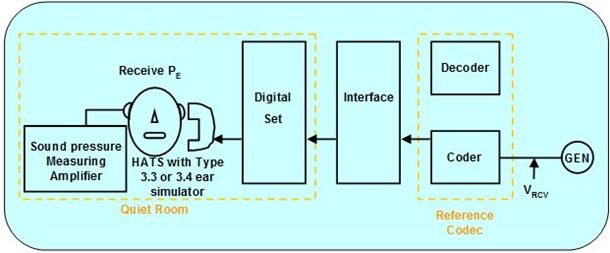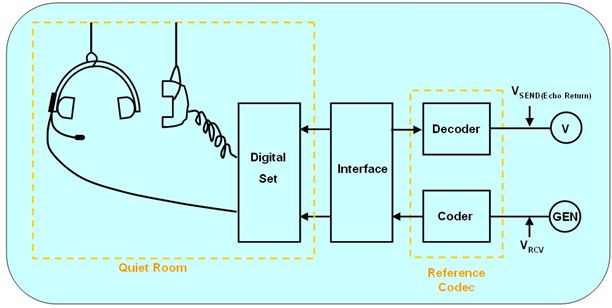
- Noise & Vibration Test
- Microsoft Teams Certification
- Zoom Certification
- Google Meet Certification
- Amazon Alexa Certification
- Google Assistant Test
- Microsoft Cortana Test
- Electro-acoustic Device Performance Test
- EN 50332 Maximum Sound Pressure Test
- MOS-LQO
- Architecture & Room Acoustics
- USI Stylus Certification
TIA-920 VoIP Speech Quality Test Service


About “Telecommunications Telephone Terminal Equipment Test”
Recently, the voice communication over non-traditional way such as the internal and local area networks is more and more popular. Much software (Skype, Microsoft Office Communicator … etc) support the communication function on different platforms. How to define the voice quality performance during communication becomes an important issue. A telephone is defined as a device that terminates networks and provides telephony voice service. Transmission contains many forms such as local area networks, firewire/IEEE-1394, USB (universal serial bus), public ISDN or digital over twisted pair wire. Applications include voice over internet protocol (VoIP), and PCM-based telephones, whether connected through modems, gateways, or PBXs (Private Branch Exchange) and personal computer-based telephones. The devices which provide communication over network can be divided three groups: handset, headset and handsfree. The coupling between telephone and device may be by a cord, a short-range air-interface (e.g. a radio interface, an electric field interface, a magnetic field interface or an infra-red interface). However, despite of which groups they fall or what kind of connection way it is always important to have proper objective information of these products for manufactures making audio equipments, not only for seeking the possibilities to improve the performance, but also for helping clients or end-user to choose the devices they need. ANSI/TIA/EIA-920 establishes audio performance requirements for wideband (150 to 6800 Hz) telephony. The common used characteristics are tabled as following and details are given after the table.

|
Category
|
Test requirement
|
|
Handset
|
Frequency Response (Sending & Receiving)
Loudness Rating (Sending & Receiving) Receive Volume Control Talker Sidetone Masking Rating (STMR) Noise (Sending & Receiving) Single Frequency Interference (Sending & Receiving) Receive Comfort Noise (advisory) Distortion and Noise (Sending & Receiving) Weighted Terminal Coupling Loss (TCLw) Stability Loss Maximum Acoustic Pressure (Steady State Input & Peak) Packet Voice Latency (Sending & Receiving , advisory) |
|
Headset
|
Frequency Response (Sending & Receiving)
Loudness Rating (Sending & Receiving) Talker Sidetone Masking Rating (STMR) Noise (Sending & Receiving) Single Frequency Interference (Sending & Receiving) Distortion and Noise (Sending & Receiving) Weighted Terminal Coupling Loss (TCLw) Maximum Acoustic Pressure (Steady State Input & Peak) |
|
Handsfree
|
Frequency Response (Sending & Receiving)
Loudness Rating (Sending & Receiving) Receive Volume Control Noise (Sending & Receiving) Receive Single Frequency Interference Distortion and Noise (Sending & Receiving) Weighted Terminal Coupling Loss (TCLw) Stability Loss |
For The Acoustic Characteristic of Sending and Receiving Path
I. Frequency Response –
Send frequency response is the ratio of the voltage output of the reference codec to the sound pressure at the Mouth Reference Point (MRP). Measurement should be over a minimum range of 100Hz to 8000Hz.
Send frequency response is the ratio of the voltage output of the reference codec to the sound pressure at the Mouth Reference Point (MRP). Measurement should be over a minimum range of 100Hz to 8000Hz.

Receive frequency response is the ratio of the sound pressure measured in the ear simulator to the voltage input to the reference codec. Measurement should be over a minimum range of 100Hz to 8000Hz. The frequency response measured with the Type 3.3 or 3.4 ear simulator must be transformed to the ear reference point (ERP).

Fig.2 Receive Frequency Response Measurement Method (example: Handset)
II. Loudness Rating –
Send loudness rating (SLR) is the loudness loss in the send direction from the acoustic signal at the mouth reference point (MRP) to the send signal at the digital reference point (Refer to ITU-T Rec.P79). The SLR shall be calculated using the 1/3rd octave sensitivity data collected from the send frequency response measurement.
Receive loudness rating (RLR) is the loudness loss in the receive direction from the digital reference point to the ear reference point. The RLR shall be calculated using the 1/3rd octave sensitivity data collected from the receive frequency response measurement.
Send loudness rating (SLR) is the loudness loss in the send direction from the acoustic signal at the mouth reference point (MRP) to the send signal at the digital reference point (Refer to ITU-T Rec.P79). The SLR shall be calculated using the 1/3rd octave sensitivity data collected from the send frequency response measurement.
Receive loudness rating (RLR) is the loudness loss in the receive direction from the digital reference point to the ear reference point. The RLR shall be calculated using the 1/3rd octave sensitivity data collected from the receive frequency response measurement.
III. Receive Volume Control –
The RLR is measured with the volume control set at a position that is within the RLR tolerance range. The same RLR measurement is then made with the volume control set at its maximum position. The difference between the two RLR values is the minimum handset volume control range.
The RLR is measured with the volume control set at a position that is within the RLR tolerance range. The same RLR measurement is then made with the volume control set at its maximum position. The difference between the two RLR values is the minimum handset volume control range.
IV. Talker Sidetone Masking Rating –
The sidetone masking rating (STMR) is the ratio of the acoustic output signal from the receiver at the ear reference point (ERP) to the acoustic input signal at the mouth reference point (MRP) over the specified band (100 to 8000Hz). It is desirable to be constant over the receive volume control range. The frequency response measured with the Type 3.3 or 3.4 ear simulator must be transformed to the ear reference point (ERP). STMR shall be tested at the reference control, minimum, maximum volume setting.
The sidetone masking rating (STMR) is the ratio of the acoustic output signal from the receiver at the ear reference point (ERP) to the acoustic input signal at the mouth reference point (MRP) over the specified band (100 to 8000Hz). It is desirable to be constant over the receive volume control range. The frequency response measured with the Type 3.3 or 3.4 ear simulator must be transformed to the ear reference point (ERP). STMR shall be tested at the reference control, minimum, maximum volume setting.
V. Noise –
Send noise is the 5 second average noise level at the digital transmit output with the telephone transmitter isolated from ambient noise and mechanical disturbances.
Receive noise is the 5 second average noise level measured at the output of the telephone receiver with the digital telephone receiving the digital quiet code. The measurement results must be transformed from DRP to ERP. The reference volume control setting shall be used.
Send noise is the 5 second average noise level at the digital transmit output with the telephone transmitter isolated from ambient noise and mechanical disturbances.
Receive noise is the 5 second average noise level measured at the output of the telephone receiver with the digital telephone receiving the digital quiet code. The measurement results must be transformed from DRP to ERP. The reference volume control setting shall be used.
VI. Single Frequency Interference –
The single frequency interference (narrow-band noise) is an impairment that can be perceived as a tone depending on its level relative to the overall weighted noise level. The weighted noise level in narrow band is not more than 31Hz.
The narrow-band noise in receive path is measured at the output of the telephone receiver with the telephone receiving the digital quiet code. The reference volume control setting shall be used.
The single frequency interference (narrow-band noise) is an impairment that can be perceived as a tone depending on its level relative to the overall weighted noise level. The weighted noise level in narrow band is not more than 31Hz.
The narrow-band noise in receive path is measured at the output of the telephone receiver with the telephone receiving the digital quiet code. The reference volume control setting shall be used.
VII. Receive Comport Noise –
The receive comfort noise of telephone is the short-term average background noise level measured at the output of the telephone receiver with the digital telephone receiving either a silence indication packet from the transmitting telephone or no packets from the transmitting telephone for some non-transient period of time. Comfort noise is introduced to replace actual background noise. The level should roughly match the loudness of the original background noise. Users are likely to feel annoyed if the comfort noise is greater than the original noise than if it is less than the original noise.
The handset is mounted in the HATS position with the receiver coupled to the ear simulator. The digital interface is sent a quiet code – the code that represents silence for the coder format. The reference volume control setting shall be used.
The receive comfort noise of telephone is the short-term average background noise level measured at the output of the telephone receiver with the digital telephone receiving either a silence indication packet from the transmitting telephone or no packets from the transmitting telephone for some non-transient period of time. Comfort noise is introduced to replace actual background noise. The level should roughly match the loudness of the original background noise. Users are likely to feel annoyed if the comfort noise is greater than the original noise than if it is less than the original noise.
The handset is mounted in the HATS position with the receiver coupled to the ear simulator. The digital interface is sent a quiet code – the code that represents silence for the coder format. The reference volume control setting shall be used.
VIII. Distortion and Noise –
The distortion and noise is the ratio of the signal power to the total A-weighted distortion and noise power of the digitally encoded signal output. Apply several level signals at different frequencies.
In receive path, the reference volume control setting shall be used.
The distortion and noise is the ratio of the signal power to the total A-weighted distortion and noise power of the digitally encoded signal output. Apply several level signals at different frequencies.
In receive path, the reference volume control setting shall be used.
IX. Weighted Terminal Coupling Loss –
The weighted terminal coupling loss (TCLw) provides a measure of the echo performance under normal conversation, i.e., single far-end talker condition. The use of echo control devices on the handset can affect the measurement of TCLw. The result would likely be different under cases of either single far-end talker or double-talk. The TCLw measurement is intended to represent a single far-end talker.
TCLw is measured in free-air in such a way that the inherent mechanical coupling of the handset/headset is not affected. The reference volume control setting shall be used.
The attenuation from digital input (Receive) to digital output (Send) is measured in 1/12th octave bands (or R40) for frequencies from 300 to 6700Hz.
The weighted terminal coupling loss (TCLw) provides a measure of the echo performance under normal conversation, i.e., single far-end talker condition. The use of echo control devices on the handset can affect the measurement of TCLw. The result would likely be different under cases of either single far-end talker or double-talk. The TCLw measurement is intended to represent a single far-end talker.
TCLw is measured in free-air in such a way that the inherent mechanical coupling of the handset/headset is not affected. The reference volume control setting shall be used.
The attenuation from digital input (Receive) to digital output (Send) is measured in 1/12th octave bands (or R40) for frequencies from 300 to 6700Hz.

Fig.3 Terminal Coupling Loss measurement Method (example: Handset & Headset)
X. Stability Loss –
The stability loss is a measure of the contribution of the telephone set to the overall network stability requirements. Stability loss is defined as the minimum loss from the digital input (receive) to the digital output (send) at any test frequency..
The stability loss is a measure of the contribution of the telephone set to the overall network stability requirements. Stability loss is defined as the minimum loss from the digital input (receive) to the digital output (send) at any test frequency..
XI. Maximum Acoustic Pressure –
The long duration maximum acoustic pressure is the steady state (> 500ms; for short duration, the peak period is less than 500ms vice versa) sound pressure disturbance emitted from a telephone receiver, caused by the maximum excursions of the receiving digital signal. Telephone sets with adjustable receive levels shall be adjusted to the maximum setting. The requirements are under study so far.
XII. Packet Voice Latency –
Telephone sets that employ packet voice transmission may add significant delay to the voice signal due to packetization, compression, de-jitter and queuing mechanisms. ITU-T G.114 recommends that the maximum end-to-end latency should be less than 150ms, to minimum the effects on conversations. The requirements are advisory, but the intent is to ensure that any combination of different telephone vendor send and receive latencies will remain under 100ms for the overall telephone component. This allows for an additional 50ms of delay in the packet network to meet G.114 recommendations. To minimize telephone set latency as much as possible.
Send latency is defined as the time measured from when an acoustic signal leaves a mouth simulator playing a telephone’s handset to the time its digitized representation arrives at that telephone’s packet network interface. All delays inherent in the measurement system itself must be calibrated out.
Receive latency is defined as the time measured from when a digitized, packetized representation of a signal arrives at that telephone’s packet network interface to when it analog reproduction is received at an ear simulator sealed to that telephone’s handset. All delays inherent in the measurement system itself must be calibrated out.
Send latency is defined as the time measured from when an acoustic signal leaves a mouth simulator playing a telephone’s handset to the time its digitized representation arrives at that telephone’s packet network interface. All delays inherent in the measurement system itself must be calibrated out.
Receive latency is defined as the time measured from when a digitized, packetized representation of a signal arrives at that telephone’s packet network interface to when it analog reproduction is received at an ear simulator sealed to that telephone’s handset. All delays inherent in the measurement system itself must be calibrated out.
Contact With PAL
If you need more info, please contact with PAL’s sales representative,
E-mail: sales@pal-acoustics.com
Phone: 886-2-26272515
